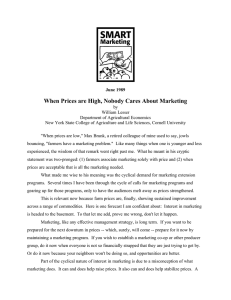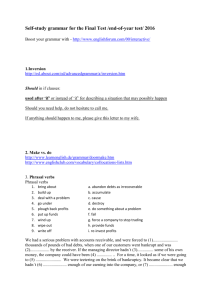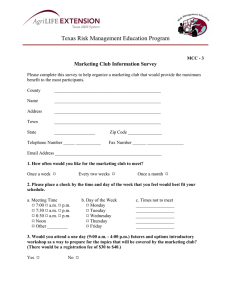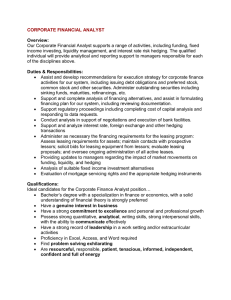Document 12238717
advertisement
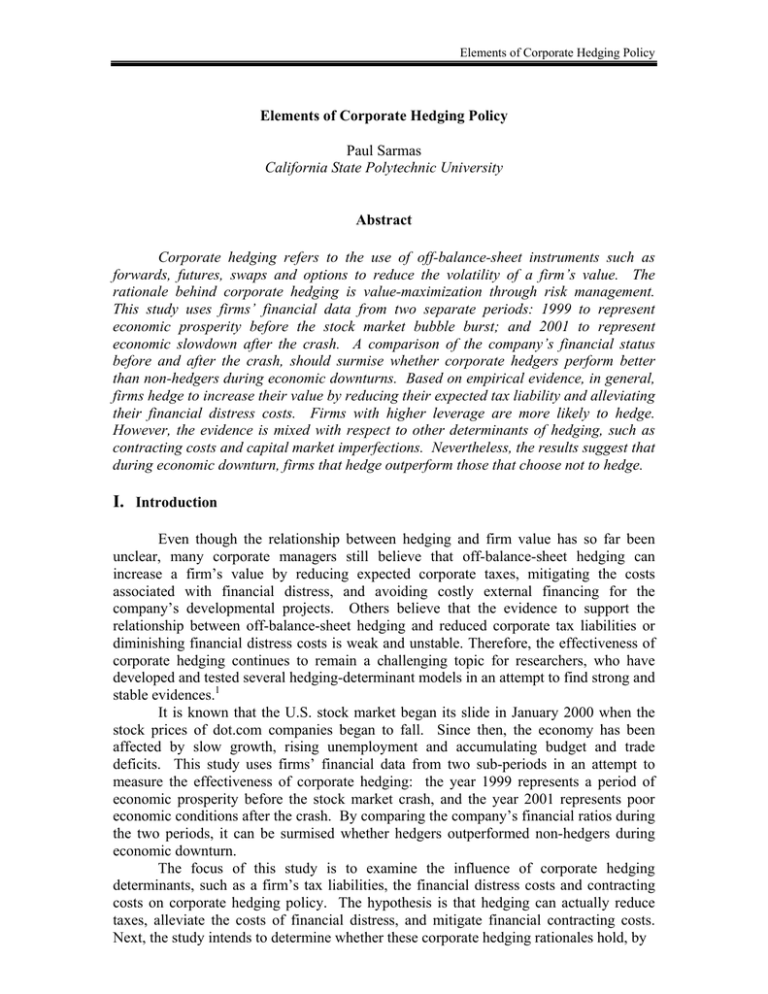
Elements of Corporate Hedging Policy Elements of Corporate Hedging Policy Paul Sarmas California State Polytechnic University Abstract Corporate hedging refers to the use of off-balance-sheet instruments such as forwards, futures, swaps and options to reduce the volatility of a firm’s value. The rationale behind corporate hedging is value-maximization through risk management. This study uses firms’ financial data from two separate periods: 1999 to represent economic prosperity before the stock market bubble burst; and 2001 to represent economic slowdown after the crash. A comparison of the company’s financial status before and after the crash, should surmise whether corporate hedgers perform better than non-hedgers during economic downturns. Based on empirical evidence, in general, firms hedge to increase their value by reducing their expected tax liability and alleviating their financial distress costs. Firms with higher leverage are more likely to hedge. However, the evidence is mixed with respect to other determinants of hedging, such as contracting costs and capital market imperfections. Nevertheless, the results suggest that during economic downturn, firms that hedge outperform those that choose not to hedge. I. Introduction Even though the relationship between hedging and firm value has so far been unclear, many corporate managers still believe that off-balance-sheet hedging can increase a firm’s value by reducing expected corporate taxes, mitigating the costs associated with financial distress, and avoiding costly external financing for the company’s developmental projects. Others believe that the evidence to support the relationship between off-balance-sheet hedging and reduced corporate tax liabilities or diminishing financial distress costs is weak and unstable. Therefore, the effectiveness of corporate hedging continues to remain a challenging topic for researchers, who have developed and tested several hedging-determinant models in an attempt to find strong and stable evidences.1 It is known that the U.S. stock market began its slide in January 2000 when the stock prices of dot.com companies began to fall. Since then, the economy has been affected by slow growth, rising unemployment and accumulating budget and trade deficits. This study uses firms’ financial data from two sub-periods in an attempt to measure the effectiveness of corporate hedging: the year 1999 represents a period of economic prosperity before the stock market crash, and the year 2001 represents poor economic conditions after the crash. By comparing the company’s financial ratios during the two periods, it can be surmised whether hedgers outperformed non-hedgers during economic downturn. The focus of this study is to examine the influence of corporate hedging determinants, such as a firm’s tax liabilities, the financial distress costs and contracting costs on corporate hedging policy. The hypothesis is that hedging can actually reduce taxes, alleviate the costs of financial distress, and mitigate financial contracting costs. Next, the study intends to determine whether these corporate hedging rationales hold, by Southwest Business and Economics Journal/2004-2005 testing 1999 and 2001 financial data of S&P500 companies using the logistic regression method. The remaining portion of this article is divided into four sections. In section II, the literature on corporate hedging policy is reviewed and a summary of the existing financial models of hedging determinants is presented. The structure of the corporate hedging model and the application of the logistic regression method used to test the model, as well as a brief description of data and resources are discussed in section III. Section IV reports and analyzes the empirical evidence. The final section is the summary and conclusion. II. Corporate Hedging Rationale Literature For years, economists have conducted research on corporate hedging activities, and developed different models to evaluate corporate hedging policies. Despite their numerous reports regarding hedging, there seems to be no single and acceptable framework that can be used to guide hedging strategies.2 One possible explanation for lack of consistent empirical evidence is that previous studies have focused on why hedging makes sense, instead of placing emphasis on how much or what sort of hedging is optimal for a particular firm. There are important rationales behind hedging strategy, which are widely discussed in the hedging world. Hedging strategy can be influenced by the following determinants. A. Managerial Motives Stulz (1984) argues that corporate hedging is directly influenced by the risk aversion of managers, who may hold a relatively large portion of their wealth in the firm’s stock. Unlike outside stockholders who are able to diversify their portfolios effectively and independently from the firms’ diversification activities, the managers can benefit significantly from a corporate hedge policy aimed at reducing the variance of total value. Essentially, the managers’ attitudes toward risk and their inclination toward hedging exert direct influence on the corporate hedging policy. Peter Tufano (1996) examined a database that details corporate risk management activity in the North American gold mining industry. The evidence supported the theory that firms whose managers held more options were less involved in management of gold price volatility. On the other hand, firms whose managers held more stock were more involved in managing the gold price risk. Overall, risk management was negatively associated with the tenure of firms’ CFOs, perhaps reflecting managerial interests, skills or preferences. In other studies, the authors drew a similar conclusion: A firm tends to hedge more as the sensitivity of the total portfolio to stock price increases; but as the sensitivity of the stock option portfolio to stock return volatility increases, the firm tends to hedge less.3 B. Corporate Taxes In a progressive corporate tax environment, corporate hedging can reduce the expected tax liability of a firm facing over a wide range of possible income outcomes.4 The tax-benefit argument can be presented in two formats. First, given the convexity function of taxes, meaning a more volatile earnings stream leads to higher expected taxes, corporate hedging would lower the volatility of earning and resulting tax liabilities. Elements of Corporate Hedging Policy Second, in the absence of corporate hedging, firms with large negative earnings are forced to carry forward their tax losses to later periods, and hence lose tax benefits in the present value sense. In other words, hedging increases the present value of these tax shields by smoothing out corporate earnings. The tax savings benefit of hedging was addressed in a number of articles.5 In general these studies focused on two tax incentives for corporation to hedge: (1) increase debt capacity and interest tax deductions, and (2) reduce expected tax liability if the tax function is convex. The authors tested whether these incentives affected the extent of corporate hedging with derivatives by using an explicit measure of tax function convexity. The results showed no relationship between tax function convexity or tax incentive and holdings of hedging instruments by corporations. C. Financial Distress Cost There are two specific issues concerning financial distress cost. First, firms with a large amount of debt and variable earnings are exposed to a higher degree of default risk, and thus carry higher financial distress cost. Smith and Stulz (1985) argue that capital structure hedging would reduce earnings variability and allow all firms to increase debt capacity without significantly increasing their credit risk. Second, according to Nance, Smith and Smithson (1993), smaller firms are more likely to hedge to avoid the high cost of bankruptcy, reorganization and liquidation. In other words, smaller firms have greater difficulty absorbing the fixed cost portion of financial distress, and hence would benefit more from a corporate hedging policy. One method of measuring the expected distress costs is by multiplying the debt ratio by the equity market-to-book ratio. This would account for both the probability of distress and the associated cost. Haushalter’s (2000) empirical results show that the probability of financial distress increased with increasing debt ratio. The evidence also shows that the cost of distress increased with increasing market-book ratio. D. Capital Market Imperfections Froot, Scharfstein and Stein (1993) examined the relationship between capital market imperfections and demand for corporate hedging, and asserted that firms with large investment budgets are more likely to hedge in order to reduce their cost of acquiring external funds. Firms, through corporate hedging, can reduce the volatility of their internal cash flow, and hence reduce the need to access capital markets for external funds. The firms’ objective should be to minimize overall cost of capital by raising capital from less expensive sources, which in turn would increase the profitability of investment projects. This relationship was supported in the study by Haushalter (2000), where debt ratios affected hedging decisions in the oil and gas industries, and that these decisions were made jointly. The hedging and debt policies were jointly tested using simultaneous equation regressions. The evidence showed that leverage exerted a positive influence on the use of derivatives. The author also found that hedging led to greater debt capacity. However, a study by Mian (1996) showed mixed results, where hedgers did not have higher market-to-book ratios. The study found that hedging was uncorrelated with leverage, but that it was influenced by the firm’s size and positively correlated with dividend yield and dividend payout. Southwest Business and Economics Journal/2004-2005 E. Contracting Costs The contracting cost or agency cost refers to the costs incurred by firms resulting from the stockholders-bondholders conflict. According to Myers (1997), if a large fraction of the cash flow from a project accrues to the current bondholders, it is possible that the firm could decide to forgo positive NPV projects and reject a potentially profitable project. Such opportunistic behavior by the stockholders could prompt bondholders to protect themselves by lowering their offer price. In order to persuade buyers to pay higher prices for bonds, the firm must assure them that wealth transfers will not take place. The effect of corporate hedging to alleviate financial contracting costs is twofold. First, hedging ensures that a corporation has sufficient internal funds available to take advantage of profitable investment opportunities with minimal need for costly external sources of funds. All else equal, the more difficulty a firm has in obtaining outside financing, the more costly a shortfall in cash flow will be, and the greater the value hedging provides. Second, as discussed by Mayers and Smith (1990), hedging reduces expected bankruptcy costs by reducing the variability of cash flows. In a study by Nance, Smith and Smithson (1993), a logistic regression analysis was employed, and the results showed that firms that hedged face more convex tax functions, had less coverage of fixed claims, were larger in size, had more growth options in their investment opportunity set, and employed fewer hedging substitutes than those firms that didn’t hedge. Therefore, a conclusion was drawn that firms hedge to reduce expected tax liabilities, to lower expected transaction costs, and to control agency problems. III. Empirical Model and Data The objectives of the study are to test the corporate hedging determinants. First the tax saving benefits model, which demonstrates that company hedge to reduce the expected tax liability, is examined. Second, the theory which states that firms are more likely to hedge to avoid financial distress costs is tested. Third, the theory that the companies with higher leverage should have more benefits on hedging is tested. Fourthly, examine firms with more growth options in their investment opportunity set, which are more likely to hedge to avoid contracting costs are examined. Finally, the liquidity ratio, leverage ratio, return on asset, return on equity and dividend payout ratios of S&P500 companies are calculated and used to reflect the financial status of companies. The ratios of companies in 1999 are compared with those in 2001 to show the different performance during economic boom (1999) and economic slowdown (2001). The intention is to provide evidence that hedgers perform better during a financial turndown than do nonhedgers. A. Empirical Model The model includes a number of hedging determinants that are believed to have an impact on the firms’ decision whether to hedge. One hedging determinant is a tax savings benefit, which is believed to reduce a firm’s tax liability through hedging. If a firm’s effective tax schedule is convex, expected taxes are reduced by hedging. Tax preference items like tax loss carry forwards, foreign tax credits, and investment tax credits make the effective tax schedule convex. In this model, tax loss carry forwards is Elements of Corporate Hedging Policy chosen as the variable to reflect aspects of a firm’s effective tax function and test whether the benefits of hedging should be greater, the greater the firm’s tax loss carry forwards. Another determinant is the financial distress costs. The argument is that hedging lowers the probability that a firm will experience financial distress by reducing the variance of its cash flow and value. The cost reduction depends on the possibility a firm may encounter financial distress if it does not hedge and the level of costs a firm will incur if it does encounter financial distress. The benefits of hedging are directly related to the size of the firm’s fixed claims relative to the value of its assets, which in turn is proportionate to firm size. Therefore, the relation between hedging and firm size becomes an empirical question. The question is whether hedging is more commonly practiced by firms with more total assets or firms with less in assets. In this model the firm value is chosen as the variable to test the claim that hedgers are better able to reduce financial costs and increase firm value as opposed to non-hedgers. The next determinant to be included in the model is the financial contracting costs. Financial contracting costs are caused by underinvestment problems resulting from agency conflict between bondholders and shareholders. The underinvestment problem is directly linked to the level of debt in the firm’s capital structure, where firms with higher leverage are more likely to hedge. Hedging is believed to reduce the probability of a firm defaulting on its promised payments, thereby increasing stockholders’ expected cash flow from a positive NPV project. Three variables are used to measure leverage: EBIT-toInterest ratio, Debt-to-Firm value ratio and Leverage Ratio. An alternative method of testing contracting costs is to establish whether firms with high growth opportunities tend to hedge more. The explanation is that firms use derivatives to reduce the variability of their income stream and to ensure that adequate internal funds are available to take advantage of attractive projects. Therefore, the more growth opportunities firms have, the more likely that they will hedge. The model incorporates two variables representing growth opportunities stemming from investment projects: R&D-to-Firm Value ratio and Book Value-to-Market Value ratio. The hedgers are expected to have higher leverage ratios and more growth opportunities than nonhedgers. Finally, in order to test the hedgers’ financial stability during an economic downturn, five ratios are selected which are typically used to evaluate the credit rating of a firm. These are liquidity ratio, return on asset, return on equity, leverage ratio, and dividend payout ratio. If corporate hedging rationales prove to be correct, hedger’s financial health measured by these ratios should be better than non-hedgers. B. Testing Methodology This paper employs the research method known as the logistic regression model, which is a procedure for modeling a 0/1 dependent variable that does not require the independent variables to be normally distributed. As a result, many other types of variables, including indicator variables, are in the possible set of explanatory variables. In this case, the dependent variables are firms that are recognized as hedgers and nonhedgers. The two variables are coded as Y=1 and Y=0, which is a binary dependent variable. Firms that hedge can be coded as 1, while firms that don’t hedge can be coded as 0. Because the dependent variable is either 0 or 1, it can be shown that the conditional mean of y given x, µy/x, is equal to the probability that the observation belongs to the indicated group: µy/x = p = Pr(Y=1). Probabilities must be between 0 and Southwest Business and Economics Journal/2004-2005 1; thus to model the conditional mean of y, a function that is restricted to lie between 0 and 1 must be used. The function considered in logistic regression is called the logistic function. The logistic function is a nonlinear function of the regression coefficients and must be solved by a nonlinear regression routine. Logistic regression routines usually use a procedure called maximum likelihood estimation to estimate the regression coefficients in the logistic regression function. The logistic regression is derived and formulated in the following format: Pr( y i = 1 ⊥ xi , β ) = 1 − F (− xi' β ) (1) Pr( y i = 0 ⊥ xi , β ) = F (− xi' β ) Where: yi denotes firms that hedge or don not hedge, xi denotes hedging determinants, F is a continuous and increasing function that has real values, and β is the estimated coefficient of hedging determinants. If the logistic (LOGIT) specification is selected for the “F” cumulative distribution function, then the final version of the regression equation would be: ⎛ e − xi β ⎞ e xi β ⎟ Pr( y i = 1 ⊥ xi , β ) = 1 − ⎜ = ⎜ (1 + e xi' β ) ⎟ (1 + e xi' β ) ⎝ ⎠ ' ' (2) In addition, the comparisons of means of the variables are performed in an attempt to further support the results coming from the logistic regression analysis. The mean comparison is also critical when analyzing the financial ratios to test the fourth hypothesis. Normally, this type of logistic regression research based 1-year data. In this study, two years of financial data is used: 1999 and 2001. The year 1999 symbolizes strong economic conditions and a bull stock market, whereas the year 2001 symbolizes a weak economy and a bear stock market. C. Data Definition and Source The data are collected from the financial statements of Standard and Poor’s 500 firms for the 1999 and 2001 period using the COMPUSTAT databank. The Disclosure Database Extractor is used to extract the financial reports. Information on hedging activities of the companies is available in these financial reports. If the company is engaged in hedging activities not for trading purposes, it is identified as “hedger”. Otherwise, if the company does not use any off-balance sheet instruments such as derivatives, swaps or options to hedge, it is identified as “non-hedger”. Financial institutions excluded from the study’s sample are those that use derivatives for both hedging and speculating given their own business nature. In total, 115 firms were omitted from the sample: 47 financial firms and 68 firms with no disclosure reports. Of the remaining 385 companies, 241 are identified as hedgers and 144 are called nonhedgers. The independent variables are Tax Loss Carry Forward, Firm value, Book value/Firm value, Debt/Firm, EBIT/Interest, Leverage ratio, Liquidity ratio, ROA, ROE and Dividend payout ratio. All the ratios were either collected directly from the COMPUSTAT databank or were calculated based on information extracted from the databank. Elements of Corporate Hedging Policy IV. Empirical Evidence The empirical results are shown in tables 1 through 5. Tables 1 and 2 summarize the results of the maximum likelihood estimation technique, which report the estimated coefficients, asymptotic standard errors, z-statistics, and corresponding ρ-values. The estimated “β” coefficients measure the impact of the explanatory variables on the dependent variable, and the sign of the coefficient shows the direction of impact. A positive value of “β” implies that an increase in the explanatory variable would increase the probability of hedging and vice-versa. The z-statistic and p-value measure the significance of the estimated coefficients. If the z-statistic is between ±1.96, the independent variable carries a significant explanatory power and the null hypothesis cannot be rejected at the 5 percent level. When the ρ-value is less than 0.05, the null hypothesis cannot be denied. The comparison of means of ratios is also employed for further analysis of the hypotheses. The mean estimation and mean comparison of explanatory variables are summarized in tables 3 and 4. These estimates are for hedgers and non-hedgers for the two periods of 1999 and 2001. The ratio calculations and comparison of hedger and nonhedger firms for periods 1999 and 2001 are summarized in Table 5. The estimate of the company’s tax loss carry forward provides support for taxbased explanation for hedging, where hedging appears to be positively related to tax loss carry forward. The z-statistic and p-value prove that tax loss carry forward is a significant factor in explaining dependent variable. The positive values of estimated coefficients in both years imply that an increasing tax loss carry forward was associated with an increasing probability to hedge. In addition, as shown in tables 3 and 4, by comparing means of tax loss carry forwards of hedgers to non-hedgers in 1999 to those in 2001, it is seen that hedgers carry more tax loss carry forwards than non-hedgers. This is consistent with the hypothesis that hedgers have more tax benefits than do non-hedgers. The z-statistic and ρ-value suggest that the estimated coefficient of firm value variable is significant. It supports the hypothesis that hedging can increase a firm’s value. However, the negative coefficient in 1999 indicates that smaller firms tend to hedge more, whereas the positive coefficient in 2001 suggests that larger firms are more likely to hedge. The comparison of means of firm value in 1999 and 2001 ends up with the same mixed results, where the evidence of whether smaller firms or larger firms tend to hedge is inconclusive. The investment growth opportunity is represented by the ratios R&D/Firm Value and Book Value/Market Value. The z-statistic and p-value of R&D/Firm Value fail to indicate that the hedger firms have more growth opportunity than non-hedgers. The estimated coefficients and corresponding statistics of the Book/Market Value ratio in 1999 and 2001 are similarly inconclusive. The parameter estimates suggest that probability of hedging is negatively related to Book/Market Value, which is inconsistent with the predictions derived from the contracting cost model. The mean-comparison analysis is consistent with the proposed relationship between hedging and firm size, but the statistical results are much weaker than those provided by the logistic regression model. In general, the evidence based on the empirical relation between hedging and Book/Market Value as well as hedging and R&D/Firm Value fail to recognize the contracting cost and capital market imperfections as determinants of corporate hedging. The absence of a significant relationship between hedging and Debt/Firm Value is implied by the z-statistic and ρ-value in both 1999 and 2001. However, the statistical results of the leverage ratio and EBIT/Interest Expense show a robust relationship Southwest Business and Economics Journal/2004-2005 between a firm’s hedging policy and its debt policy. The empirical evidence simply indicates a hypothesis that hedgers have more leverage than non-hedgers. The negative coefficients of EBIT/Interest Expense with the dependent variable indicate that the lower the ratio, the higher probability to hedge. The positive coefficients of Leverage Ratio suggest that the higher the ratio, the higher probability to hedge. The mean estimation of financial ratios and mean-comparison of these ratios between hedgers and non-hedgers in 1999 and 2001 are shown in Table 5. The overall empirical evidence supports the claim that hedgers perform better financially than do non-hedgers during economic downturns. The liquidity ratio improved for the hedgers at an annual growth rate of 2.72%, whereas non-hedgers showed a negative growth rate of 4.4%. Hedgers appear to have kept a stable leverage ratio, with an annual growth rate of 4%, whereas non-hedgers experienced a 16.7% increase in debt ratio. ROA for hedgers declined more than that for non-hedgers decline from 1999 to 2001. ROE for hedgers declined more than for non-hedgers; however, hedgers paid more dividends than nonhedgers in both 1999 and 2001, evidenced by their Dividend Payout Ratios. It also is important to note that, with the exception of liquidity ratio, the logistic regression estimations indicate that all other ratios are all statistically significant. V. Summary and Conclusion The reviewed literature is testimony to the importance of hedging to the goal of corporate value maximization. Previous studies attempted to establish a relationship between numerous financial variables and the corporate hedging strategy. The resulting empirical evidence was varied and mixed in implication. This study selected two periods: 1999, representative of an economic growth cycle, and 2001, representative of a recessionary cycle. Despite numerous constraints and limitation in data, the generated empirical results provide a basis for a consistent view of hedging as a component of corporate financial policy. The results summarized in this study show that firms hedge in order to increase their economic values by reducing the expected tax liability and alleviate the financial distress costs. In addition, the generated statistical results imply that firms with higher leverage are more likely to hedge, and those firms with a hedging policy in place are better-off financially than those who do not hedge during economic downturns. The empirical evidence is mixed with respect to contracting costs and capital market imperfection components of the hedging model. The logistic regression results of Book/Market Value and hedging and R&D/Firm Value variables are inconsistent with the proposed relationship between hedging and its two determinants: contracting costs and capital market imperfections. On the other hand, there is a robust statistical relationship between hedging and leverage variables. The evidence shows that hedgers have more leverage than non-hedgers. This indicated that hedging firms are better able to reduce contracting costs. The results also fail to determine concretely whether larger firms tend to hedge more than smaller firms. Even though in some cases the empirical results are mixed, the overall evidence is clear in identifying certain variables as determinants of hedging policy, and suggests that a hedging strategy should become an integral part of modern corporation operations. There are other related issues that have to be addressed separately, such as the type of risks that should be hedged, partial versus full hedging strategy, and the choice of hedging instruments. Elements of Corporate Hedging Policy Endnotes 1 For instance, refer to studies by Mayers and Smith (1985); Smith and Stulz (1985); He (2004); and Froot, Scharfstein, and Stein (1993). 2 For a detailed discussion of these topics, refer to articles published by Smith, Smithson, and Wilford (1990); Stulz (1990); Breeden and Viswanathan (1990); and Lessard (1990). 3 For further study of the related issues, see Carpenter (2000) and Lambert, Larcker, and Verrecchia (1991). 4 Please use studies by Mayers and Smith (1982); and Smith and Stulz (1985) as references. 5 Please see articles by Graham and Smith (1999); Haushalter (2000); and Graham and Rogers (2002). Southwest Business and Economics Journal/2004-2005 References Cummins, D. J., Phillips, R. D., & Smith, S. D., (1998). The Rise of Risk Management. Federal Reserve Bank of Atlanta Economic Review, First Quarter, 30-40. Dielman, T. E. (2001). Applied Regression Analysis for Business and Economics. (3rd Ed.) Pacific Grove, CA: Duxbury/Thomson Learning. Froot, K. A., Scharfsteirn, D. S., and Stein, J. C. (1993). Risk Management: Coordinating Corporate Investment and Financing Policies. Journal of Finance, 48 (5), 1629-1658. Geczy, C., Bernadette, M. A., and Schrand, C. (1997). Why Firms Use Currency Derivatives? Journal of Finance, 52, 1323-1354. Graham, J. R. and Rogers, D. A. (2002). Do Firms Hedge in Response to Tax Incentives? Journal of Finance, 57 (2), 815-839. Graham, J. R. and Smith, C. W. (1999). Tax Incentive to Hedge. Journal of Finance, 54, 2241-2262. Greene, W. H. (1997). Econometric Analysis. (3rd Ed.) Upper Saddle River, N.J.: Prentice Hall. Haushalter, D. G. (2000). Financing Policy, Basis Risk, and Corporate Hedging: Evidence from Oil and Gas Producers. Journal of Finance, 55 (1),107-152. He, F. (2004). Corporate Hedging Determinants. Unpublished master’s thesis, California State Polytechnic University, Pomona, California. Knopf, J. D., Nam, J. and Thornton, J. H. Jr. (2002). The Volatility and Price Sensitivities of Managerial Stock Option Portfolios and Corporate Hedging. Journal of Finance, 57 (2), 801-813. Lambert, R. A., Larcker, D. F., and Verrecchia, R. E. (1991). Portfolio Considerations in Valuing Executive Compensation. Journal of Accounting Research, 29, 129-149. Lessard, D. (1990). Global Competition and Corporate Finance in the 1990s. Continental Bank of Journal of Applied Corporate Finance, 3(4), 59-72. Mayer, D. and Smith, C. W. (1987). Corporate Insurance and the Under-investment Problem. Journal of Risk and Insurance, 54, 45-54. Mian, S. L. (1996). Evidence on Corporate Hedging Policy. Journal of Financial and Quantitative Analysis, 31(3), 419-439. Nance, D. R., Smith, C. W. JR., and Smithson, C. W. (1993). On the Determinants of Corporate Hedging. Journal of Finance, 48 (1), 267-284. Elements of Corporate Hedging Policy Smith, C. and Stulz, R. (1985). The Determinants of Firms’ Hedging Policies. Journal of Financial and Quantitative Analysis, 28, 391-405. Smith, C. W., Smithson, C., and Wilford, D. S. (1990). Managing Financial Risk. New York, New York: Harper and Row Publishing. Stulz, R. (1984). Optimal Hedging Policy. Journal of Financial and Quantitative Analysis, 19(2), 127-140. Stulz, R. (1990). Managerial Discretion and Optimal Financing Policies. Journal of Financial Economics, 26(1), 3-28. Tufano, P. (1996). Who Manages Risk? An Empirical Examination of Risk Management Practices in the Gold Mining Industry. Journal of Finance, 51 (4), 1097-1137. Southwest Business and Economics Journal/2004-2005 Table 1 Logistic Regression Parameter Estimates Dependent Variables: Hedgers vs. Non-hedgers (1999) Variable Constant Book Value/Firm Value Debt/Firm Value Dividend Payout Ratio EBIT/Interest Expense Firm Value Leverage Ratio Liquidity Ratio R&D/Firm Value Return on Assets Ratio Return on Equity Ratio Tax Loss Carry Forward Coefficient 0.67867 -2.76337 3.99248 0.05015 -7.40E-06 -1.18E-07 0.04974 -0.30613 34.0817 0.33537 -0.28409 0.00083 Mean Dependent Variance S.D. Dependent Variance Sum of Squared Residual S.E. of Regression Akaike Information Criterion Schwarz Criterion 0.62594 0.48450 77.1638 0.45483 1.23962 1.36284 Standard Error 0.475821 1.345947 1.903547 0.080801 7.01E-06 1.67E-07 0.079926 0.118128 10.60314 2.731785 0.736329 0.000603 z-Statistics 1.426 -2.053 2.097 0.621 -1.055 -0.705 0.622 -2.592 3.214 0.123 -0.386 1.378 Probability 0.154 0.040 0.036 0.535 0.292 0.481 0.534 0.010 0.001 0.902 0.699 0.168 Elements of Corporate Hedging Policy Table 2 Logistic Regression Parameter Estimates Dependent Variables: Hedgers vs. Non-hedgers (2001) Variable Constant Book Value/Firm Value Debt/Firm Value Dividend Payout Ratio EBIT/Interest Expense Firm Value Leverage Ratio Liquidity Ratio R&D/Firm Value Return on Assets Ratio Return on Equity Ratio Tax Loss Carry Forward Coefficient -0.18099 -2.18341 4.41723 0.02338 -4.60E-06 2.98E-06 -0.22697 0.06018 38.5131 5.49962 -1.16755 5.62E-05 Mean Dependent Variance S.D. Dependent Variance Sum of Squared Residual S.E. of Regression Akaike Information Criterion Schwarz Criterion 0.6260 0.4845 74.1156 0.44576 1.20122 1.32444 Standard Error 0.45668 1.12557 1.51385 0.06055 4.27E-06 2.43E-06 0.11027 0.04325 9.18461 2.07756 0.66019 0.00011 z-Statistics -0.396 -1.940 2.918 0.386 -1.077 1.224 -2.058 1.392 4.193 2.645 -1.769 0.509 Probability 0.692 0.052 0.004 0.699 0.282 0.221 0.040 0.164 0.000 0.008 0.077 0.610 Table 3 Comparison of Means (1999) Independent Variables Tax Shields: Tax Loss Carry Forwards Firm Size: Firm Value Investment Opportunity Set: Book Value/Market Value R&D/Firm Value Leverage: Debt/Firm Value Leverage Ratio Means Hedgers (H) (NH) Non-hedgers Δ Means: (H) – (NH) 89.80455 44.61585 45.1887 43360.53 253779.4 -210418.87 0.563165 0.009524 0.469766 0.006054 0.093399 0.00347 0.38811 2.874525 0.278024 1.58283 0.110086 1.291695 Southwest Business and Economics Journal/2004-2005 Table 4 Comparison of Means (2001) Independent Variables Tax Shields: Tax Loss Carry Forwards Firm Size: Firm Value Investment Opportunity Set: Book Value/Market Value R&D/Firm Value Leverage: Debt/Firm Value Leverage Ratio Means Hedgers (H) (NH) Non-hedgers Δ Means: (H) – (NH) 483.6059 132.8889 350.717 153981.5 22983.51 130997.99 0.61457 0.012543 0.53018 0.009156 0.08439 0.003387 0.41756 3.116871 0.302122 2.112884 0.115438 1.003987 Table 5 Comparison of Means of Ratios Independent Variables Liquidity Ratio: 1999 2001 Annual Growth Leverage Ratio: 1999 2001 Annual Growth Return on Asset: 1999 2001 Annual Growth Return on Equity: 1999 2001 Annual Growth Dividend Payout Ratio: 1999 2001 Annual Growth Means Hedgers – (H) (NH) Non-hedgers – 1.286974 1.35702 0.0272 2.339153 2.133861 -0.0439 2.874525 3.116871 0.0422 1.58283 2.112884 0.1674 0.00647 0.035465 -0.2259 0.079181 0.019973 -0.3739 0.168856 0.085657 -0.2464 0.174872 0.129569 -0.1295 0.541581 1.80743 1.1687 0.277869 0.116124 -0.2910


